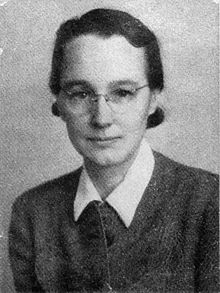Myrtle Bachelder
Myrtle Bachelder | |
|---|---|
 Bachelder in 1942 | |
| Born | Myrtle Claire Bachelder March 13, 1908 Worcester, Massachusetts, U.S. |
| Died | May 22, 1997 (aged 89) Chicago, Illinois, U.S. |
| Education | Middlebury College (BS) |
| Known for | Chemistry of uranium and rare-earth elements |
| Scientific career | |
| Fields | |
| Institutions | |
Myrtle Claire Bachelder (March 13, 1908 – May 22, 1997) was an American chemist and Women's Army Corps officer, who is noted for her secret work on the Manhattan Project atomic bomb program, and for the development of techniques in the chemistry of metals.
Early life and career
Myrtle Claire Bachelder was born on March 13, 1908, in Worcester, Massachusetts. She earned a Bachelor of Science degree from Middlebury College in 1930, and became a high school science teacher and athletics coach in South Hadley Falls, Massachusetts. She received her master of education degree from Boston University.[1][2][3]
World War II: the atomic bomb
During
"Manhattan" was the code name for the special military division dedicated to developing an atomic weapon. In

These methods were used during the preparation of
A "pencil and paper man", immersed in physics theory, who was more than a little amazed by the Los Alamos lab machinery. Bachelder recalled Oppenheimer standing in front of her lab's most important and expensive instrument punching buttons at random ... He asked "What does this do?" Then he'd punch another button ... He might have wrecked the machine if he hadn't finally been persuaded to leave it alone.[9]
Contribution to post-war developments in nuclear energy
The conclusion of the Second World War was also the dawning of a new "Atomic Age", in which the peacetime potential of nuclear energy began to be explored. Bachelder was among the scientists who opposed the May-Johnson Bill of October 1945, a Congressional bill proposed by the
Scientific research and later career
After leaving the Army, Bachelder became a research chemist at the University of Chicago, where the first self-sustaining nuclear reaction had been achieved in 1942. Nobel Laureate James Franck had been director of the Chemistry Division of the Metallurgical Laboratory during the earlier phases of the Manhattan Project. Bachelder joined the University's Institute for the Study of Metals (renamed as the James Franck Institute in 1967), and she conducted further research in metallochemistry.[12][13][14]
Among other achievements, Bachelder developed methods for the purification of the rare elements tellurium and indium.[12] Other aspects of her broad scientific expertise found application in the field of marine archaeology, when she determined the chemical composition of brass cannons found in the Aegean Sea on sunken ships.[13] She also made contributions to astrochemistry, when NASA asked her to analyze the chemistry of Moon rocks which had been collected from the Moon's surface during the Apollo missions from 1969 to 1972.[2]
Bachelder retired from the Franck Institute in 1973, and was subsequently active as an official of the American Association of Retired Persons (AARP).[2] She died in Chicago on May 22, 1997.[3]
Reflections
Bachelder believed that her role in the development of the atomic bomb, and the subsequent use of atomic weapons against Japan, had been justified in order to end the Second World War and to avoid greater loss of life that would have been entailed in a U.S. land invasion and extended conflict with Japan. Later, during the period of the Strategic Arms Limitation Talks, Bachelder stated that, although she supported nuclear arms control:
Opponents of nuclear weapons should resist the urge to take the 1940s bomb-building effort out of its proper historical context — "One cannot pull that activity out of that time, set it down in the 1980s, and pass judgement."[9]
Bachelder's always made time for her voracious reading habits. "She made the most of each day. She, too, knew the importance of working hard, ignoring the clock, and always challenging herself."[15]
Notes
- ^ a b Bell 1993, p. 29.
- ^ a b c "Myrtle C. Bachelder". Chicago Tribune. May 26, 1997. Retrieved October 12, 2013.
- ^ a b "Myrtle Bachelder". Mocavo. Retrieved October 12, 2013.
- ^ a b Howes & Herzenberg 2003, pp. 149–150.
- ^ Bell 1993, p. 8.
- ^ "Woman's Army Corps Dorm". National Park Service. Archived from the original on March 12, 2022. The identification of the dorm as a WAC dorm was found to be incorrect, and later corrected.
- ^ "Civilian Women's Dormitory". National Park Service. Retrieved May 22, 2023.
- ^ "Myrtle Bachelder". Atomic Heritage Foundation.
- ^ a b Staples, Brent (November 19, 1984). "Los Alamos Aide Recalls Dawn of Atomic Age". Chicago Sun-Times. p. 41.
- ^ Blakeslee, Howard W. (January 31, 1947). "Atomic Boiler Hints Now Off Secret List, Women Among Authors". Associated Press.
- ^ Holloway, O. Willard (February 1948). "American and British Atomic Energy Reports". University of Nebraska–Lincoln. Retrieved April 15, 2014.
- ^ ISSN 0003-2700.
- ^ .
- ISSN 0021-9584.
- ^ Salwak 2008, p. 145.
References
- Bell, Iris Y. (1993). Los Alamos WAACs/WACs: World War II, 1943–1946. Sarasota, Florida: Coastal Printing. ISBN 0-9637321-1-0.
- ISBN 0-585-38881-4.
- Salwak, Dale (2008). Teaching Life: Letters from a Life of Literature. Iowa City, Iowa: University of Iowa Press.
External links
- A Semi-Quantitative Method for the Spectrographic Analysis of Small Powders Scientific paper by Myrtle Bachelder.
